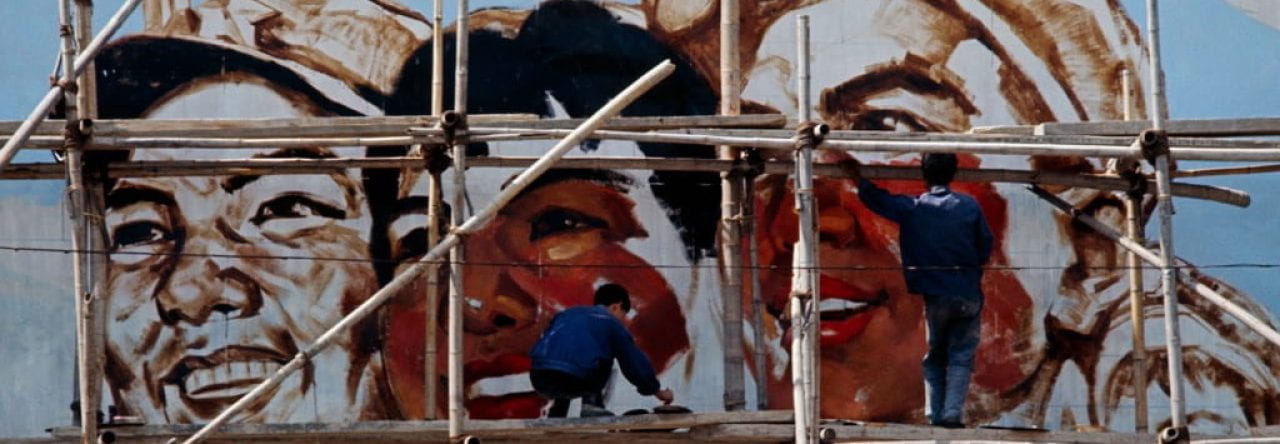
“Flowers of the Four Seasons” is a masterpiece by Zhang Daqian that showcases his talent and mastery of traditional Chinese ink and brush painting on paper. The painting is known for its vivid depiction of various flowers, each representing a season. In the upper left corner, you can see a blooming plum blossom, which is often associated with the winter season in Chinese culture because the flowers bloom in late winter, before the arrival of spring. On the upper right, there is a peach blossom, which is often associated with the spring season in Chinese culture because the flowers bloom in early spring, signaling the arrival of warmer weather and the start of a new growing season. In the lower left corner, there is a lotus flower, which is often associated with the summer season in Chinese culture because lotus flowers bloom in mid to late summer, when the weather is hot and humid. And in the lower right, a chrysanthemum, representing autumn because the flowers bloom in late summer to early fall, when the weather is starting to cool down.
The flowers are arranged in a way that creates a sense of movement, as if they are swaying in the wind. The color palette is also quite vibrant, with a mix of reds, pinks, blues, and greens creating a lively composition that is well balanced and harmonious. Each flower is depicted with a high degree of detail and realism, but also with a touch of stylization that adds to the overall aesthetic appeal. Zhang Daqian’s brushstrokes are expressive and fluid and his use of negative space gives the painting a sense of depth and perspective.
The symbolism of the flowers is also significant in Chinese culture. The plum blossom, for example, is a symbol of perseverance and hope, as the flowers are able to withstand the harsh winter weather and bloom early, signaling the arrival of a new year and new beginnings. The lotus flower symbolizes purity and enlightenment, as the flowers grow in muddy water but emerge clean and beautiful. The use of these flowers in the painting adds an additional layer of meaning and depth to the artwork.
- Huang, Y. (2018). A Study on the Aesthetic Conception of Zhang Daqian’s Landscape Paintings. Journal of Literature, History and Philosophy, 4(4), 113-116.
- Zhang, H. (2017). The Influence of the Four Seasons on Chinese Traditional Culture. Open Journal of Social Sciences, 5(6), 47-52.
- Fan, Y. (2019). Zhang Daqian and the “New Literati Painting Movement” in Modern China. Frontiers of History in China, 14(1), 69-85.


Nicholas Popeleski
After reading through Athanasia Kytoudi’s visual analysis insight on Zhang Daqian’s painting called Flowers of the Four Seasons, it inspired me to think differently about my artist’s (Feng Mengbo’s) artwork The Long March, from 2008. It made me think about Feng’s artwork in the sense that it creates a unique scene; and that I should put myself in it, looking at things from objects, colors, all the way to the type of medium used to create the scene around me. Kytoudi’s visual analysis helped me understand something new about my artist’s media artwork and how to see his style from a different perspective. It is simply by putting myself into the artwork and watching the different types of mediums as they are being used around me to really get an insight on the story behind a painting/piece of artwork.
Zeji Lin
Xu Beihong, the artist I chose, is famous for his ideological implications in his paintings of natural subjects (such as animals and plants). I enjoy reading about the symbolism of flowers in Chinese culture, which adds to the significance of this painting in terms of Zhang Daqian’s style. Based on this background, the bold use of colors is an innovative highlight that I can see from this work, which is interesting to me because Xu Beihong also has a lot of avant-garde techniques that he learned from western paintings. Generally, the traditional style of Chinese paintings does not have this kind of rich colors, so I think this work is a nice example of how studying abroad shaped an artist’s style (since Zhang Daqian studied in Japan).